Nursing Assignment on Deterioration and Wound Management
VerifiedAdded on 2023/06/10
|18
|4046
|345
AI Summary
This nursing assignment covers the assessment, observation, and management of patients with deterioration and complex wounds. It also includes the role of an assistant practitioner and the importance of observing the efficacy and side effects of medicine.
Contribute Materials
Your contribution can guide someone’s learning journey. Share your
documents today.
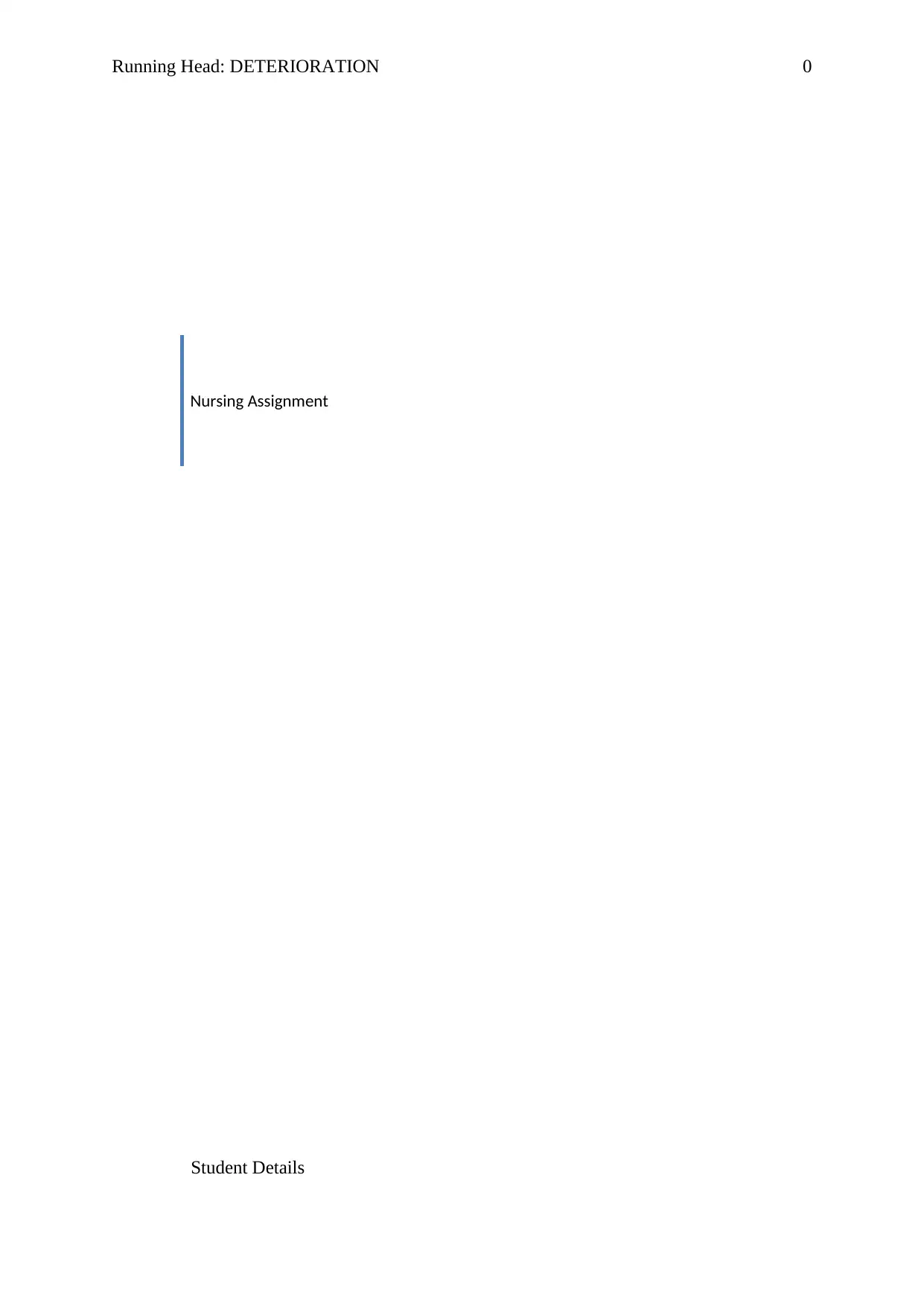
Running Head: DETERIORATION 0
Nursing Assignment
Student Details
Nursing Assignment
Student Details
Secure Best Marks with AI Grader
Need help grading? Try our AI Grader for instant feedback on your assignments.
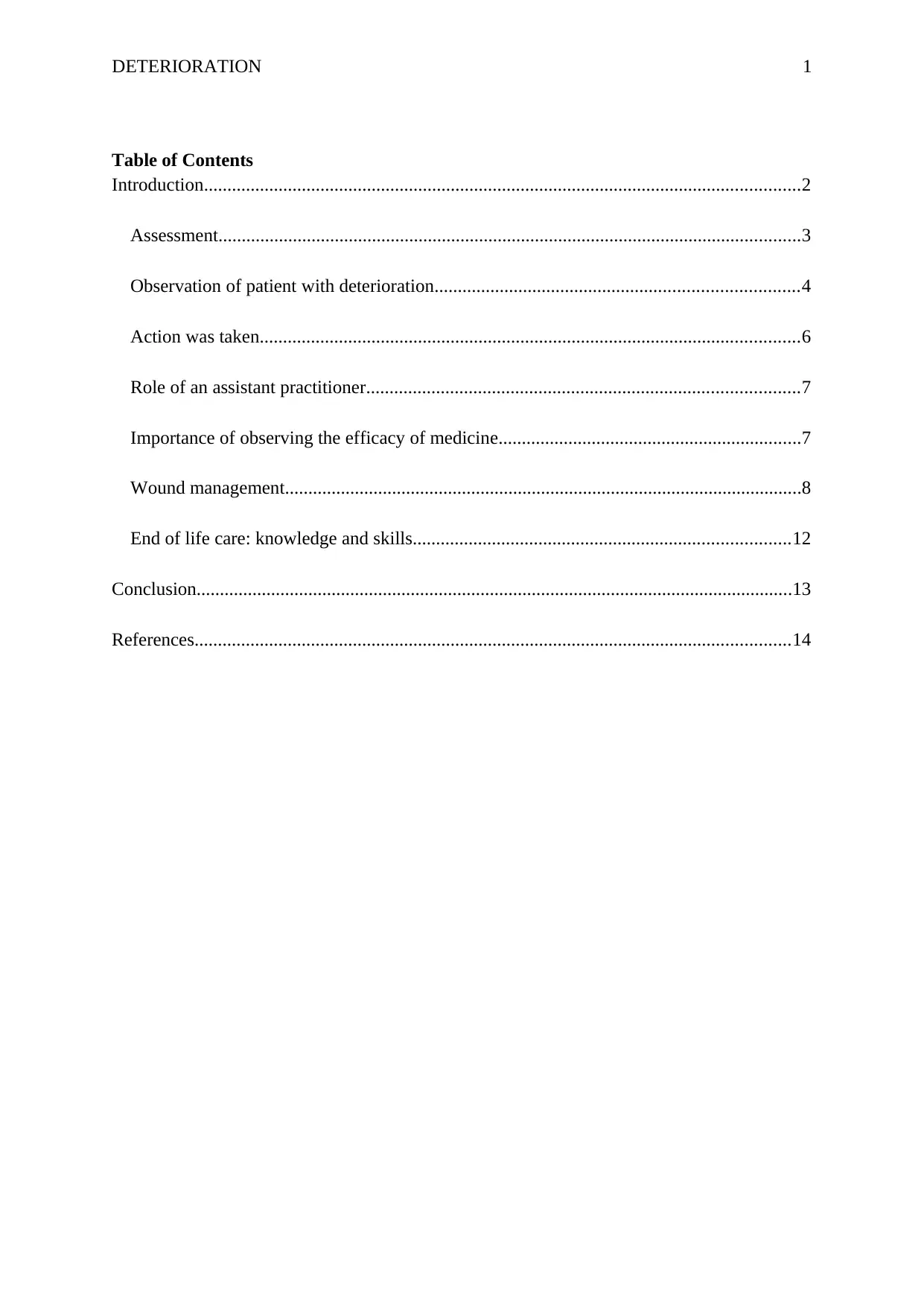
DETERIORATION 1
Table of Contents
Introduction................................................................................................................................2
Assessment.............................................................................................................................3
Observation of patient with deterioration..............................................................................4
Action was taken....................................................................................................................6
Role of an assistant practitioner.............................................................................................7
Importance of observing the efficacy of medicine.................................................................7
Wound management...............................................................................................................8
End of life care: knowledge and skills.................................................................................12
Conclusion................................................................................................................................13
References................................................................................................................................14
Table of Contents
Introduction................................................................................................................................2
Assessment.............................................................................................................................3
Observation of patient with deterioration..............................................................................4
Action was taken....................................................................................................................6
Role of an assistant practitioner.............................................................................................7
Importance of observing the efficacy of medicine.................................................................7
Wound management...............................................................................................................8
End of life care: knowledge and skills.................................................................................12
Conclusion................................................................................................................................13
References................................................................................................................................14
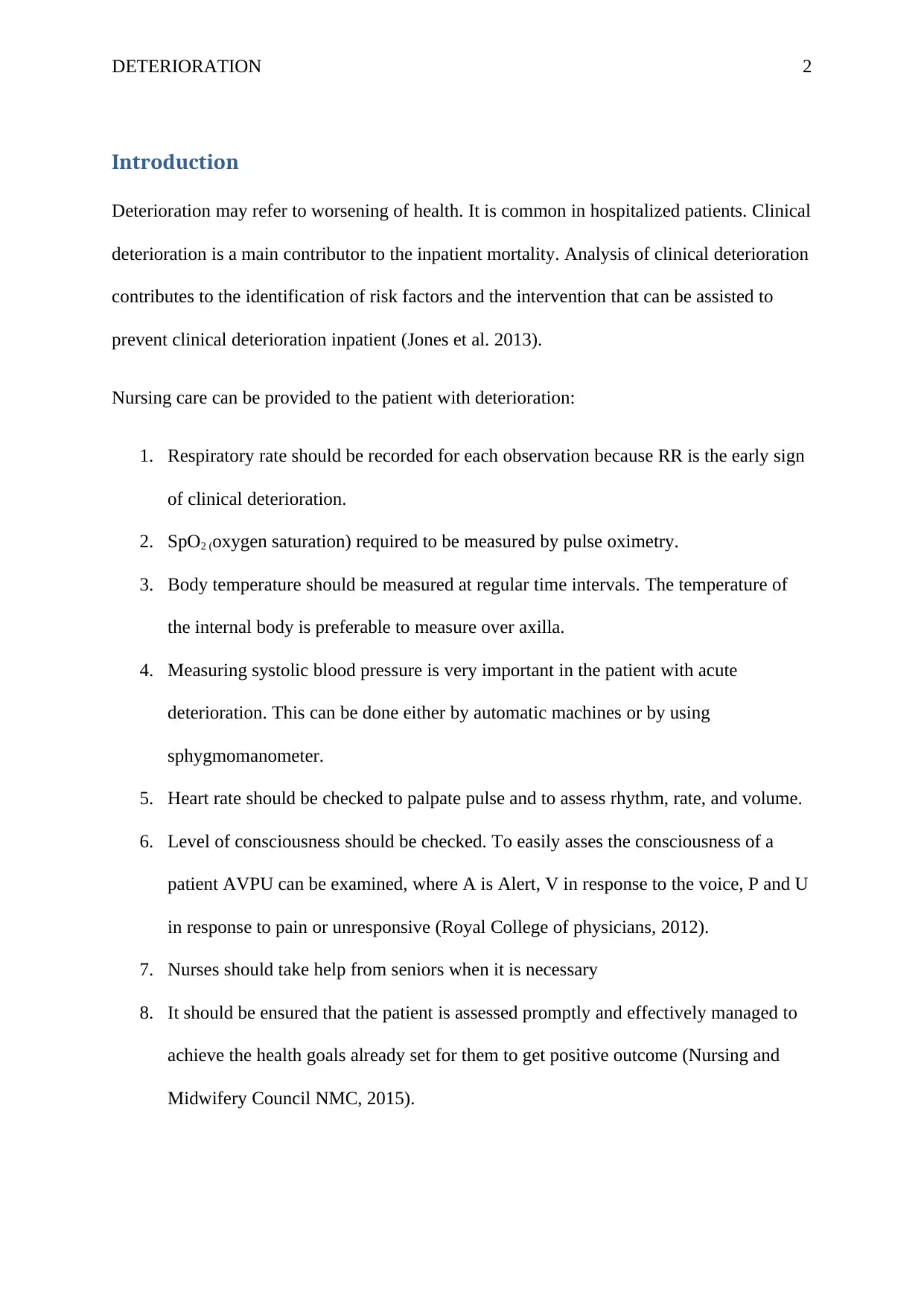
DETERIORATION 2
Introduction
Deterioration may refer to worsening of health. It is common in hospitalized patients. Clinical
deterioration is a main contributor to the inpatient mortality. Analysis of clinical deterioration
contributes to the identification of risk factors and the intervention that can be assisted to
prevent clinical deterioration inpatient (Jones et al. 2013).
Nursing care can be provided to the patient with deterioration:
1. Respiratory rate should be recorded for each observation because RR is the early sign
of clinical deterioration.
2. SpO2 (oxygen saturation) required to be measured by pulse oximetry.
3. Body temperature should be measured at regular time intervals. The temperature of
the internal body is preferable to measure over axilla.
4. Measuring systolic blood pressure is very important in the patient with acute
deterioration. This can be done either by automatic machines or by using
sphygmomanometer.
5. Heart rate should be checked to palpate pulse and to assess rhythm, rate, and volume.
6. Level of consciousness should be checked. To easily asses the consciousness of a
patient AVPU can be examined, where A is Alert, V in response to the voice, P and U
in response to pain or unresponsive (Royal College of physicians, 2012).
7. Nurses should take help from seniors when it is necessary
8. It should be ensured that the patient is assessed promptly and effectively managed to
achieve the health goals already set for them to get positive outcome (Nursing and
Midwifery Council NMC, 2015).
Introduction
Deterioration may refer to worsening of health. It is common in hospitalized patients. Clinical
deterioration is a main contributor to the inpatient mortality. Analysis of clinical deterioration
contributes to the identification of risk factors and the intervention that can be assisted to
prevent clinical deterioration inpatient (Jones et al. 2013).
Nursing care can be provided to the patient with deterioration:
1. Respiratory rate should be recorded for each observation because RR is the early sign
of clinical deterioration.
2. SpO2 (oxygen saturation) required to be measured by pulse oximetry.
3. Body temperature should be measured at regular time intervals. The temperature of
the internal body is preferable to measure over axilla.
4. Measuring systolic blood pressure is very important in the patient with acute
deterioration. This can be done either by automatic machines or by using
sphygmomanometer.
5. Heart rate should be checked to palpate pulse and to assess rhythm, rate, and volume.
6. Level of consciousness should be checked. To easily asses the consciousness of a
patient AVPU can be examined, where A is Alert, V in response to the voice, P and U
in response to pain or unresponsive (Royal College of physicians, 2012).
7. Nurses should take help from seniors when it is necessary
8. It should be ensured that the patient is assessed promptly and effectively managed to
achieve the health goals already set for them to get positive outcome (Nursing and
Midwifery Council NMC, 2015).
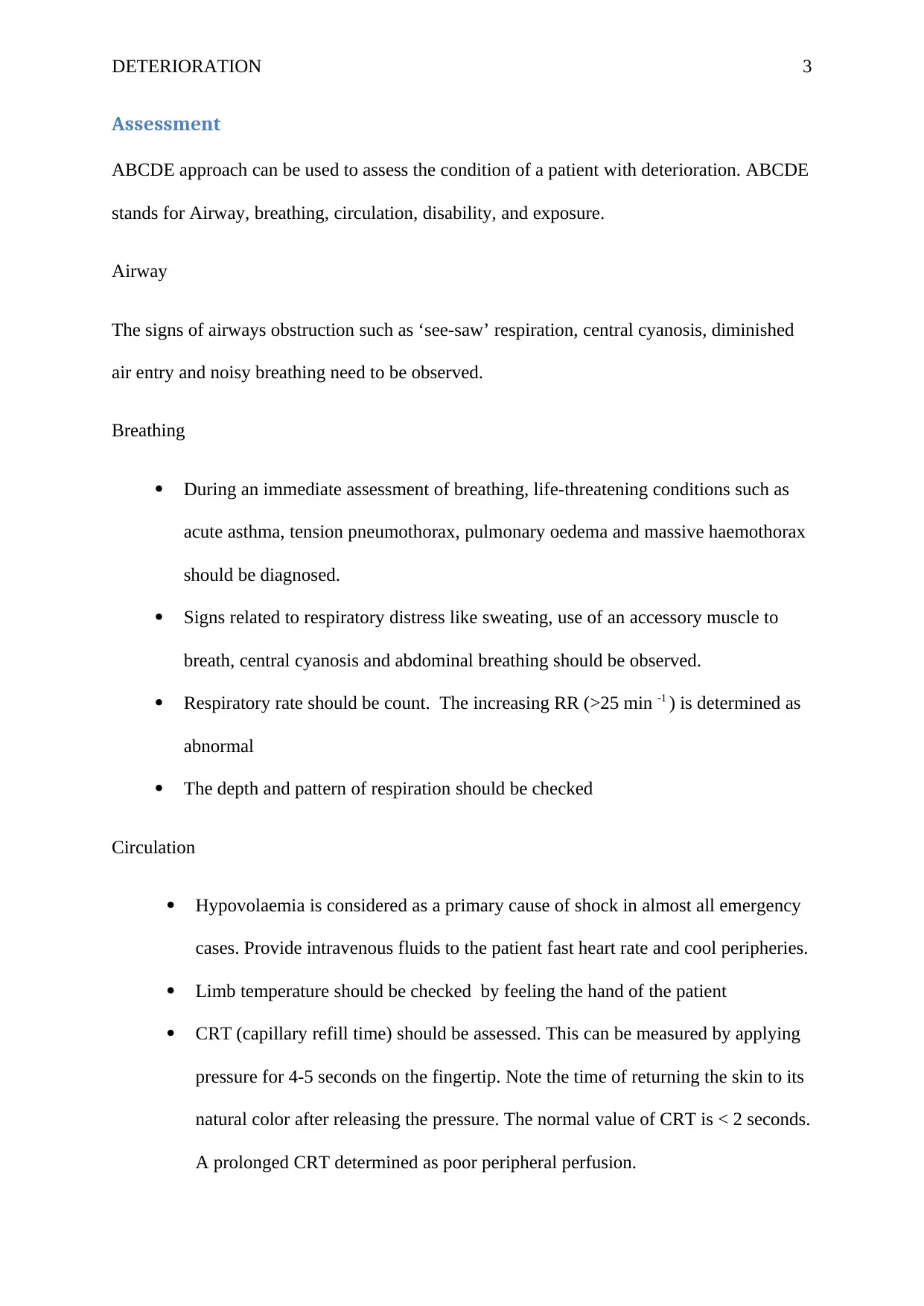
DETERIORATION 3
Assessment
ABCDE approach can be used to assess the condition of a patient with deterioration. ABCDE
stands for Airway, breathing, circulation, disability, and exposure.
Airway
The signs of airways obstruction such as ‘see-saw’ respiration, central cyanosis, diminished
air entry and noisy breathing need to be observed.
Breathing
During an immediate assessment of breathing, life-threatening conditions such as
acute asthma, tension pneumothorax, pulmonary oedema and massive haemothorax
should be diagnosed.
Signs related to respiratory distress like sweating, use of an accessory muscle to
breath, central cyanosis and abdominal breathing should be observed.
Respiratory rate should be count. The increasing RR (>25 min -1 ) is determined as
abnormal
The depth and pattern of respiration should be checked
Circulation
Hypovolaemia is considered as a primary cause of shock in almost all emergency
cases. Provide intravenous fluids to the patient fast heart rate and cool peripheries.
Limb temperature should be checked by feeling the hand of the patient
CRT (capillary refill time) should be assessed. This can be measured by applying
pressure for 4-5 seconds on the fingertip. Note the time of returning the skin to its
natural color after releasing the pressure. The normal value of CRT is < 2 seconds.
A prolonged CRT determined as poor peripheral perfusion.
Assessment
ABCDE approach can be used to assess the condition of a patient with deterioration. ABCDE
stands for Airway, breathing, circulation, disability, and exposure.
Airway
The signs of airways obstruction such as ‘see-saw’ respiration, central cyanosis, diminished
air entry and noisy breathing need to be observed.
Breathing
During an immediate assessment of breathing, life-threatening conditions such as
acute asthma, tension pneumothorax, pulmonary oedema and massive haemothorax
should be diagnosed.
Signs related to respiratory distress like sweating, use of an accessory muscle to
breath, central cyanosis and abdominal breathing should be observed.
Respiratory rate should be count. The increasing RR (>25 min -1 ) is determined as
abnormal
The depth and pattern of respiration should be checked
Circulation
Hypovolaemia is considered as a primary cause of shock in almost all emergency
cases. Provide intravenous fluids to the patient fast heart rate and cool peripheries.
Limb temperature should be checked by feeling the hand of the patient
CRT (capillary refill time) should be assessed. This can be measured by applying
pressure for 4-5 seconds on the fingertip. Note the time of returning the skin to its
natural color after releasing the pressure. The normal value of CRT is < 2 seconds.
A prolonged CRT determined as poor peripheral perfusion.
Secure Best Marks with AI Grader
Need help grading? Try our AI Grader for instant feedback on your assignments.
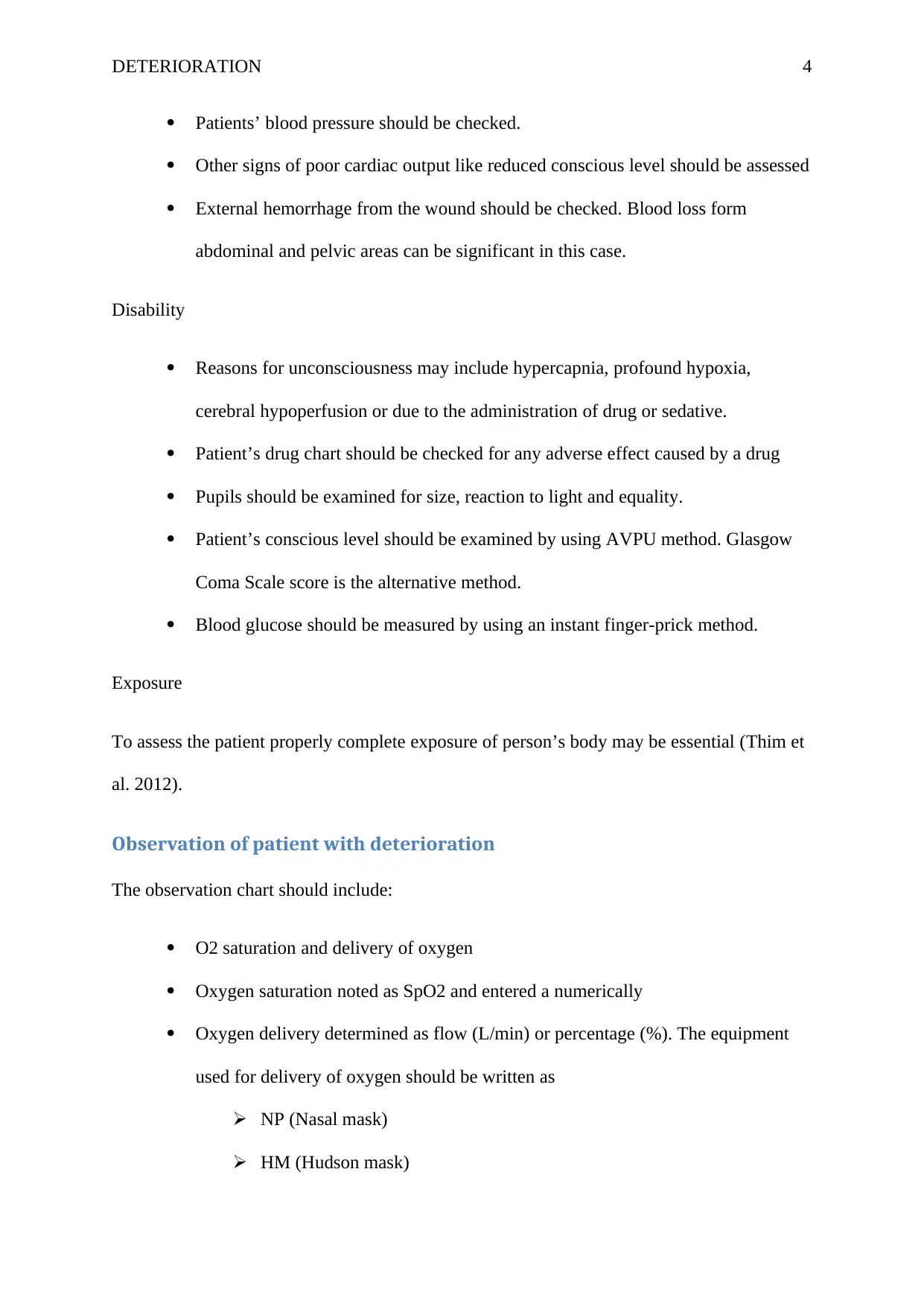
DETERIORATION 4
Patients’ blood pressure should be checked.
Other signs of poor cardiac output like reduced conscious level should be assessed
External hemorrhage from the wound should be checked. Blood loss form
abdominal and pelvic areas can be significant in this case.
Disability
Reasons for unconsciousness may include hypercapnia, profound hypoxia,
cerebral hypoperfusion or due to the administration of drug or sedative.
Patient’s drug chart should be checked for any adverse effect caused by a drug
Pupils should be examined for size, reaction to light and equality.
Patient’s conscious level should be examined by using AVPU method. Glasgow
Coma Scale score is the alternative method.
Blood glucose should be measured by using an instant finger-prick method.
Exposure
To assess the patient properly complete exposure of person’s body may be essential (Thim et
al. 2012).
Observation of patient with deterioration
The observation chart should include:
O2 saturation and delivery of oxygen
Oxygen saturation noted as SpO2 and entered a numerically
Oxygen delivery determined as flow (L/min) or percentage (%). The equipment
used for delivery of oxygen should be written as
NP (Nasal mask)
HM (Hudson mask)
Patients’ blood pressure should be checked.
Other signs of poor cardiac output like reduced conscious level should be assessed
External hemorrhage from the wound should be checked. Blood loss form
abdominal and pelvic areas can be significant in this case.
Disability
Reasons for unconsciousness may include hypercapnia, profound hypoxia,
cerebral hypoperfusion or due to the administration of drug or sedative.
Patient’s drug chart should be checked for any adverse effect caused by a drug
Pupils should be examined for size, reaction to light and equality.
Patient’s conscious level should be examined by using AVPU method. Glasgow
Coma Scale score is the alternative method.
Blood glucose should be measured by using an instant finger-prick method.
Exposure
To assess the patient properly complete exposure of person’s body may be essential (Thim et
al. 2012).
Observation of patient with deterioration
The observation chart should include:
O2 saturation and delivery of oxygen
Oxygen saturation noted as SpO2 and entered a numerically
Oxygen delivery determined as flow (L/min) or percentage (%). The equipment
used for delivery of oxygen should be written as
NP (Nasal mask)
HM (Hudson mask)
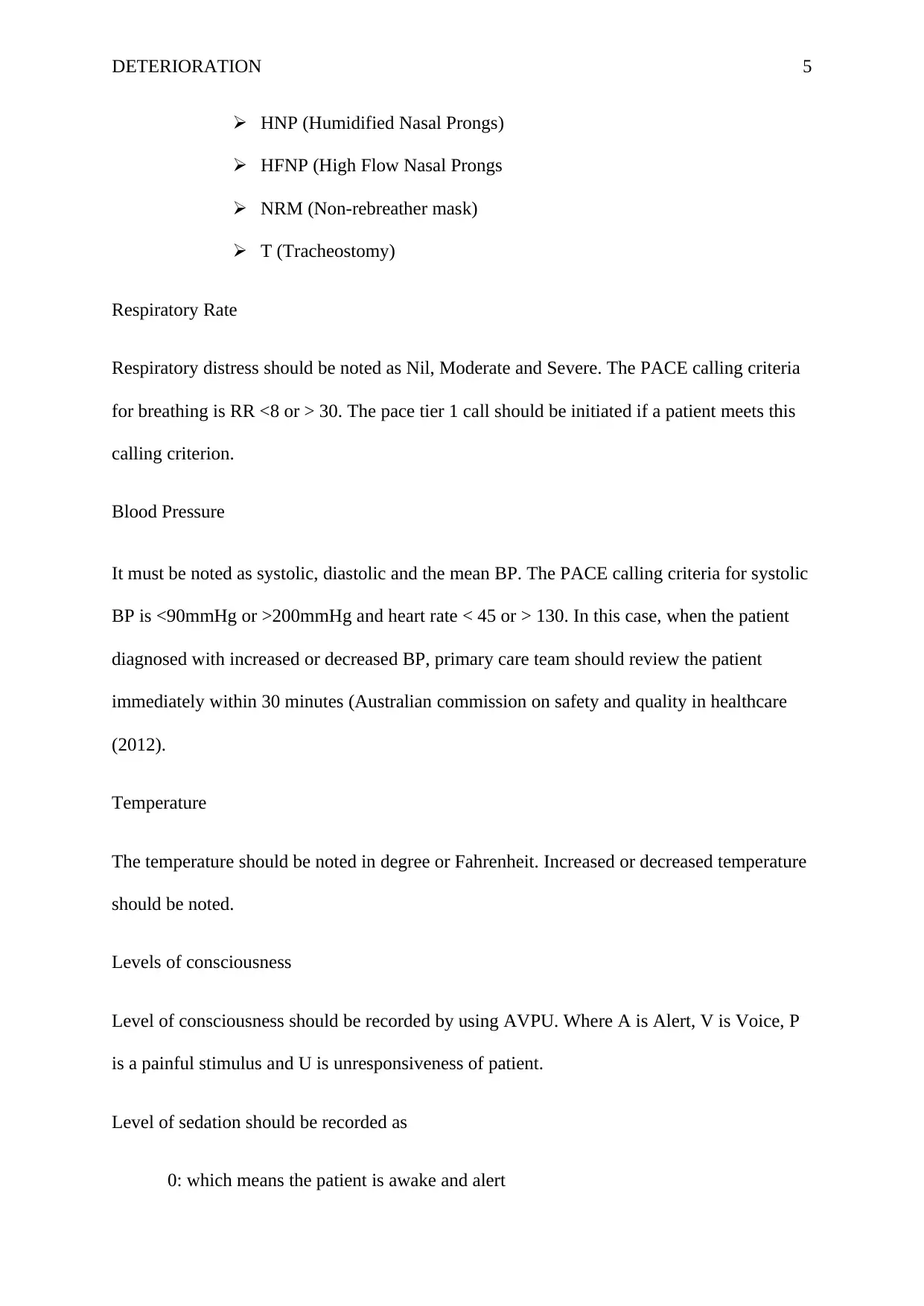
DETERIORATION 5
HNP (Humidified Nasal Prongs)
HFNP (High Flow Nasal Prongs
NRM (Non-rebreather mask)
T (Tracheostomy)
Respiratory Rate
Respiratory distress should be noted as Nil, Moderate and Severe. The PACE calling criteria
for breathing is RR <8 or > 30. The pace tier 1 call should be initiated if a patient meets this
calling criterion.
Blood Pressure
It must be noted as systolic, diastolic and the mean BP. The PACE calling criteria for systolic
BP is <90mmHg or >200mmHg and heart rate < 45 or > 130. In this case, when the patient
diagnosed with increased or decreased BP, primary care team should review the patient
immediately within 30 minutes (Australian commission on safety and quality in healthcare
(2012).
Temperature
The temperature should be noted in degree or Fahrenheit. Increased or decreased temperature
should be noted.
Levels of consciousness
Level of consciousness should be recorded by using AVPU. Where A is Alert, V is Voice, P
is a painful stimulus and U is unresponsiveness of patient.
Level of sedation should be recorded as
0: which means the patient is awake and alert
HNP (Humidified Nasal Prongs)
HFNP (High Flow Nasal Prongs
NRM (Non-rebreather mask)
T (Tracheostomy)
Respiratory Rate
Respiratory distress should be noted as Nil, Moderate and Severe. The PACE calling criteria
for breathing is RR <8 or > 30. The pace tier 1 call should be initiated if a patient meets this
calling criterion.
Blood Pressure
It must be noted as systolic, diastolic and the mean BP. The PACE calling criteria for systolic
BP is <90mmHg or >200mmHg and heart rate < 45 or > 130. In this case, when the patient
diagnosed with increased or decreased BP, primary care team should review the patient
immediately within 30 minutes (Australian commission on safety and quality in healthcare
(2012).
Temperature
The temperature should be noted in degree or Fahrenheit. Increased or decreased temperature
should be noted.
Levels of consciousness
Level of consciousness should be recorded by using AVPU. Where A is Alert, V is Voice, P
is a painful stimulus and U is unresponsiveness of patient.
Level of sedation should be recorded as
0: which means the patient is awake and alert

DETERIORATION 6
1: the patient is minimally sedative and may be tired or sleepy
2: moderately sedative
3: means the person is in deep sedation or deep sleep and rousable with only a
physical stimulation.
4: which means the patient is unrousable.
Pain Scores
Pain assessment should be done by using appropriate assessment tool such as FLACC, PAT,
and CONFORT- B scale. All the assessment tools measure the pain on the scale of 1 to 10
where 0 means no pain and 10 means severe pain.
Urine Output
Urine output should be recorded in mL/Hour. The level is <200 mls/8 hrs it is advised to call
primary care team to assess the patient (Elliott et al. 2015).
Action was taken
There are two criteria’s of PACE (patient with the acute condition for escalation) are generic
essential calling criteria for young inpatient and Obstetric essential calling criteria. If the
patient meets one or more criteria, the following actions should be taken
Immediate systematic review of the patient’s condition should be reviewed
Appropriate therapy should be applied followed by reviewing patient’s history,
physical examination, and observation chart.
In the case of life-threatening situation, the current hospital protocols should be
followed.
Registrar should review the patient in any emergency cases.
1: the patient is minimally sedative and may be tired or sleepy
2: moderately sedative
3: means the person is in deep sedation or deep sleep and rousable with only a
physical stimulation.
4: which means the patient is unrousable.
Pain Scores
Pain assessment should be done by using appropriate assessment tool such as FLACC, PAT,
and CONFORT- B scale. All the assessment tools measure the pain on the scale of 1 to 10
where 0 means no pain and 10 means severe pain.
Urine Output
Urine output should be recorded in mL/Hour. The level is <200 mls/8 hrs it is advised to call
primary care team to assess the patient (Elliott et al. 2015).
Action was taken
There are two criteria’s of PACE (patient with the acute condition for escalation) are generic
essential calling criteria for young inpatient and Obstetric essential calling criteria. If the
patient meets one or more criteria, the following actions should be taken
Immediate systematic review of the patient’s condition should be reviewed
Appropriate therapy should be applied followed by reviewing patient’s history,
physical examination, and observation chart.
In the case of life-threatening situation, the current hospital protocols should be
followed.
Registrar should review the patient in any emergency cases.
Paraphrase This Document
Need a fresh take? Get an instant paraphrase of this document with our AI Paraphraser

DETERIORATION 7
The consultant should be notified
Fever, pain, blood loss, the fluid loss should be managed immediately (SESIAHS
PACE, 2009)
Role of an assistant practitioner
The AP can independently provide medicines to the patients but not authorized to
administer medicine via IV.
The AP is only authorized to prepare and administer intra-muscular or subcutaneous
injectable medications.
AP is responsible to assess patient’s condition before administrating the medicine
An assistant practitioner prepares the medicine in the presence of a registered nurse.
Check the controlled drugs with a practitioner
AP check a patients name and number against the prescription
Check discharge medicines, outpatient medicines like clozapine against the
outpatient prescription
Administer topical and oral medicines such as the inhaler, ear or eye drops to a
patient after a designated practitioner checked the medicine and review the patient.
AP is the witness of self-administration of medicines (NHS Foundation trust, 2014)
Importance of observing the efficacy of medicine
Observing efficacy of a medicine ensures that the medicine provided to the patient
will meet the requirement of the treatment
To make sure that the treatment of a patient with deterioration will be completed on
the time
To achieve the health goals set for the patient
The consultant should be notified
Fever, pain, blood loss, the fluid loss should be managed immediately (SESIAHS
PACE, 2009)
Role of an assistant practitioner
The AP can independently provide medicines to the patients but not authorized to
administer medicine via IV.
The AP is only authorized to prepare and administer intra-muscular or subcutaneous
injectable medications.
AP is responsible to assess patient’s condition before administrating the medicine
An assistant practitioner prepares the medicine in the presence of a registered nurse.
Check the controlled drugs with a practitioner
AP check a patients name and number against the prescription
Check discharge medicines, outpatient medicines like clozapine against the
outpatient prescription
Administer topical and oral medicines such as the inhaler, ear or eye drops to a
patient after a designated practitioner checked the medicine and review the patient.
AP is the witness of self-administration of medicines (NHS Foundation trust, 2014)
Importance of observing the efficacy of medicine
Observing efficacy of a medicine ensures that the medicine provided to the patient
will meet the requirement of the treatment
To make sure that the treatment of a patient with deterioration will be completed on
the time
To achieve the health goals set for the patient
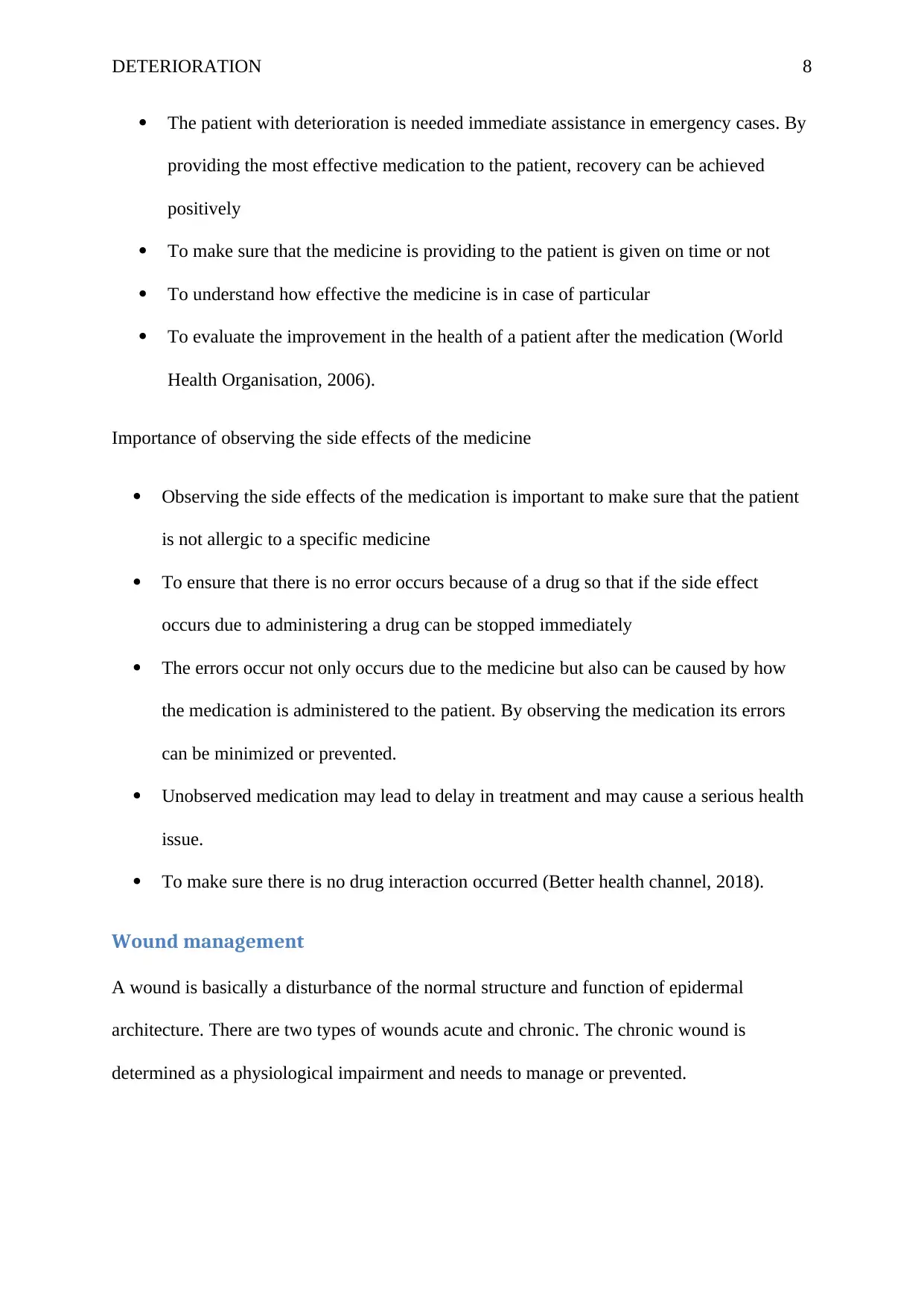
DETERIORATION 8
The patient with deterioration is needed immediate assistance in emergency cases. By
providing the most effective medication to the patient, recovery can be achieved
positively
To make sure that the medicine is providing to the patient is given on time or not
To understand how effective the medicine is in case of particular
To evaluate the improvement in the health of a patient after the medication (World
Health Organisation, 2006).
Importance of observing the side effects of the medicine
Observing the side effects of the medication is important to make sure that the patient
is not allergic to a specific medicine
To ensure that there is no error occurs because of a drug so that if the side effect
occurs due to administering a drug can be stopped immediately
The errors occur not only occurs due to the medicine but also can be caused by how
the medication is administered to the patient. By observing the medication its errors
can be minimized or prevented.
Unobserved medication may lead to delay in treatment and may cause a serious health
issue.
To make sure there is no drug interaction occurred (Better health channel, 2018).
Wound management
A wound is basically a disturbance of the normal structure and function of epidermal
architecture. There are two types of wounds acute and chronic. The chronic wound is
determined as a physiological impairment and needs to manage or prevented.
The patient with deterioration is needed immediate assistance in emergency cases. By
providing the most effective medication to the patient, recovery can be achieved
positively
To make sure that the medicine is providing to the patient is given on time or not
To understand how effective the medicine is in case of particular
To evaluate the improvement in the health of a patient after the medication (World
Health Organisation, 2006).
Importance of observing the side effects of the medicine
Observing the side effects of the medication is important to make sure that the patient
is not allergic to a specific medicine
To ensure that there is no error occurs because of a drug so that if the side effect
occurs due to administering a drug can be stopped immediately
The errors occur not only occurs due to the medicine but also can be caused by how
the medication is administered to the patient. By observing the medication its errors
can be minimized or prevented.
Unobserved medication may lead to delay in treatment and may cause a serious health
issue.
To make sure there is no drug interaction occurred (Better health channel, 2018).
Wound management
A wound is basically a disturbance of the normal structure and function of epidermal
architecture. There are two types of wounds acute and chronic. The chronic wound is
determined as a physiological impairment and needs to manage or prevented.
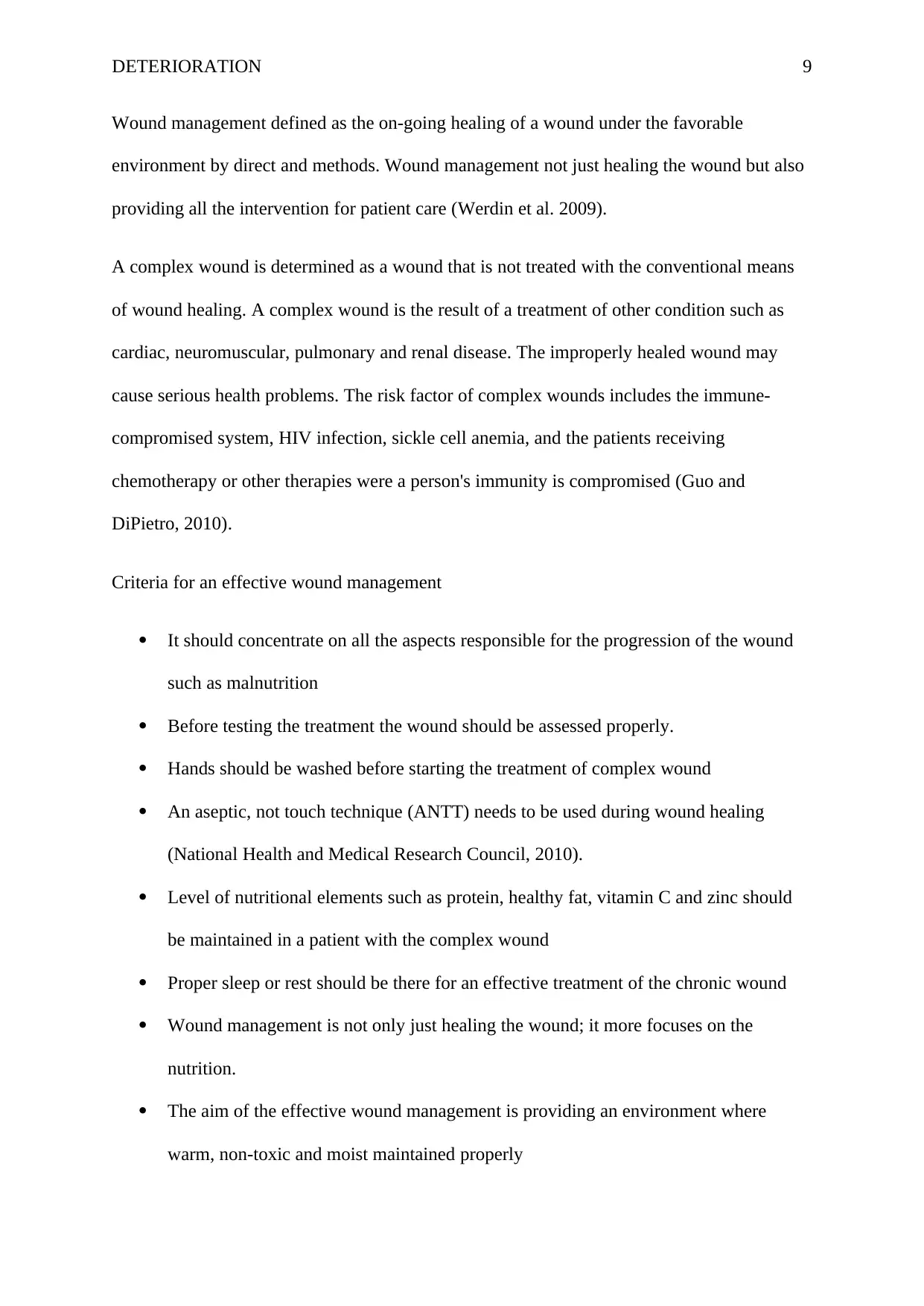
DETERIORATION 9
Wound management defined as the on-going healing of a wound under the favorable
environment by direct and methods. Wound management not just healing the wound but also
providing all the intervention for patient care (Werdin et al. 2009).
A complex wound is determined as a wound that is not treated with the conventional means
of wound healing. A complex wound is the result of a treatment of other condition such as
cardiac, neuromuscular, pulmonary and renal disease. The improperly healed wound may
cause serious health problems. The risk factor of complex wounds includes the immune-
compromised system, HIV infection, sickle cell anemia, and the patients receiving
chemotherapy or other therapies were a person's immunity is compromised (Guo and
DiPietro, 2010).
Criteria for an effective wound management
It should concentrate on all the aspects responsible for the progression of the wound
such as malnutrition
Before testing the treatment the wound should be assessed properly.
Hands should be washed before starting the treatment of complex wound
An aseptic, not touch technique (ANTT) needs to be used during wound healing
(National Health and Medical Research Council, 2010).
Level of nutritional elements such as protein, healthy fat, vitamin C and zinc should
be maintained in a patient with the complex wound
Proper sleep or rest should be there for an effective treatment of the chronic wound
Wound management is not only just healing the wound; it more focuses on the
nutrition.
The aim of the effective wound management is providing an environment where
warm, non-toxic and moist maintained properly
Wound management defined as the on-going healing of a wound under the favorable
environment by direct and methods. Wound management not just healing the wound but also
providing all the intervention for patient care (Werdin et al. 2009).
A complex wound is determined as a wound that is not treated with the conventional means
of wound healing. A complex wound is the result of a treatment of other condition such as
cardiac, neuromuscular, pulmonary and renal disease. The improperly healed wound may
cause serious health problems. The risk factor of complex wounds includes the immune-
compromised system, HIV infection, sickle cell anemia, and the patients receiving
chemotherapy or other therapies were a person's immunity is compromised (Guo and
DiPietro, 2010).
Criteria for an effective wound management
It should concentrate on all the aspects responsible for the progression of the wound
such as malnutrition
Before testing the treatment the wound should be assessed properly.
Hands should be washed before starting the treatment of complex wound
An aseptic, not touch technique (ANTT) needs to be used during wound healing
(National Health and Medical Research Council, 2010).
Level of nutritional elements such as protein, healthy fat, vitamin C and zinc should
be maintained in a patient with the complex wound
Proper sleep or rest should be there for an effective treatment of the chronic wound
Wound management is not only just healing the wound; it more focuses on the
nutrition.
The aim of the effective wound management is providing an environment where
warm, non-toxic and moist maintained properly
Secure Best Marks with AI Grader
Need help grading? Try our AI Grader for instant feedback on your assignments.
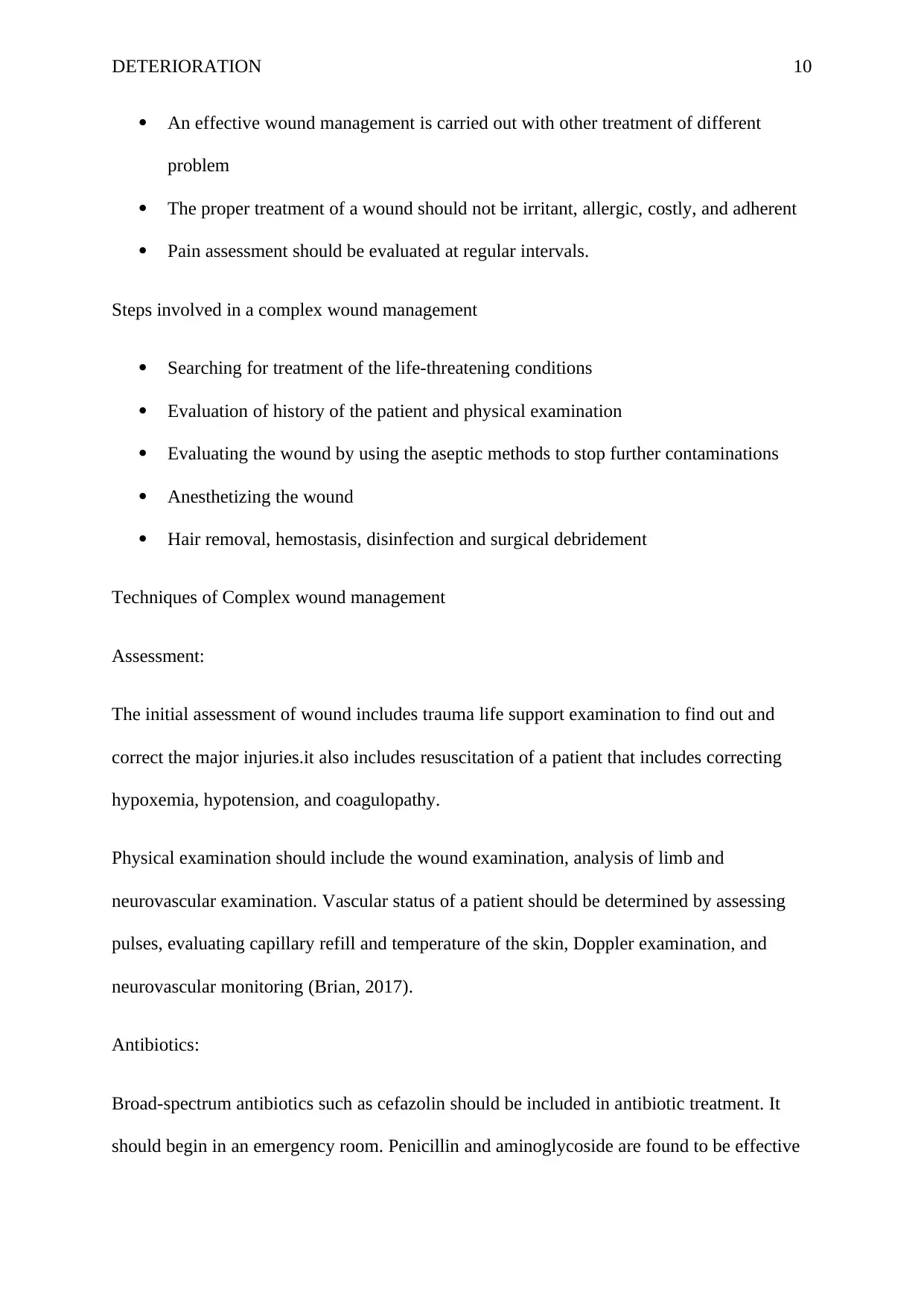
DETERIORATION 10
An effective wound management is carried out with other treatment of different
problem
The proper treatment of a wound should not be irritant, allergic, costly, and adherent
Pain assessment should be evaluated at regular intervals.
Steps involved in a complex wound management
Searching for treatment of the life-threatening conditions
Evaluation of history of the patient and physical examination
Evaluating the wound by using the aseptic methods to stop further contaminations
Anesthetizing the wound
Hair removal, hemostasis, disinfection and surgical debridement
Techniques of Complex wound management
Assessment:
The initial assessment of wound includes trauma life support examination to find out and
correct the major injuries.it also includes resuscitation of a patient that includes correcting
hypoxemia, hypotension, and coagulopathy.
Physical examination should include the wound examination, analysis of limb and
neurovascular examination. Vascular status of a patient should be determined by assessing
pulses, evaluating capillary refill and temperature of the skin, Doppler examination, and
neurovascular monitoring (Brian, 2017).
Antibiotics:
Broad-spectrum antibiotics such as cefazolin should be included in antibiotic treatment. It
should begin in an emergency room. Penicillin and aminoglycoside are found to be effective
An effective wound management is carried out with other treatment of different
problem
The proper treatment of a wound should not be irritant, allergic, costly, and adherent
Pain assessment should be evaluated at regular intervals.
Steps involved in a complex wound management
Searching for treatment of the life-threatening conditions
Evaluation of history of the patient and physical examination
Evaluating the wound by using the aseptic methods to stop further contaminations
Anesthetizing the wound
Hair removal, hemostasis, disinfection and surgical debridement
Techniques of Complex wound management
Assessment:
The initial assessment of wound includes trauma life support examination to find out and
correct the major injuries.it also includes resuscitation of a patient that includes correcting
hypoxemia, hypotension, and coagulopathy.
Physical examination should include the wound examination, analysis of limb and
neurovascular examination. Vascular status of a patient should be determined by assessing
pulses, evaluating capillary refill and temperature of the skin, Doppler examination, and
neurovascular monitoring (Brian, 2017).
Antibiotics:
Broad-spectrum antibiotics such as cefazolin should be included in antibiotic treatment. It
should begin in an emergency room. Penicillin and aminoglycoside are found to be effective

DETERIORATION 11
in grossly contaminated wounds. Tetanus toxoid can be administered if the deceased
person’s immunization is compromised (Rowan et al. 2017).
Surgical management
Debridement and hemostasis are the first steps in the surgical management of a chronic
wound. It is the removal of the unhealthy tissue from the wound for fast recovery from the
injury. This can be done by surgically, mechanically and chemically (University of Virginia
Health system 2018).
Compartment release
Various factors increase the risk of developing extremely compartment syndrome. Intra-
compartment pressure under 30 mmHg of diastolic BP indicates compartment syndrome.
Compartment release includes the release of all the compartments, prevention of the venous
drainage and keeping the skin open (Blonska-Staniec et al. 2016).
Wound irrigation
High-pressure irrigation reduces the bacterial load and traumatic tissues. The latest method of
wound irrigation is Hydrocision in which the tissues are cut and removed with water. This
method is successfully used in debridement of burnt tissues (Gabriel, 2017).
Dressing
There are various types of dressing techniques such as film dressing, foam dressing, alginates
and hydrofibers dressing (Advanced Tissue, 2018). Some dressings are impregnated with
silver which promotes the antimicrobial environment (Lo et al. 2009). The dressing should be
changed serially to allow the wound bed to become evident (Park et al. 2010)
in grossly contaminated wounds. Tetanus toxoid can be administered if the deceased
person’s immunization is compromised (Rowan et al. 2017).
Surgical management
Debridement and hemostasis are the first steps in the surgical management of a chronic
wound. It is the removal of the unhealthy tissue from the wound for fast recovery from the
injury. This can be done by surgically, mechanically and chemically (University of Virginia
Health system 2018).
Compartment release
Various factors increase the risk of developing extremely compartment syndrome. Intra-
compartment pressure under 30 mmHg of diastolic BP indicates compartment syndrome.
Compartment release includes the release of all the compartments, prevention of the venous
drainage and keeping the skin open (Blonska-Staniec et al. 2016).
Wound irrigation
High-pressure irrigation reduces the bacterial load and traumatic tissues. The latest method of
wound irrigation is Hydrocision in which the tissues are cut and removed with water. This
method is successfully used in debridement of burnt tissues (Gabriel, 2017).
Dressing
There are various types of dressing techniques such as film dressing, foam dressing, alginates
and hydrofibers dressing (Advanced Tissue, 2018). Some dressings are impregnated with
silver which promotes the antimicrobial environment (Lo et al. 2009). The dressing should be
changed serially to allow the wound bed to become evident (Park et al. 2010)
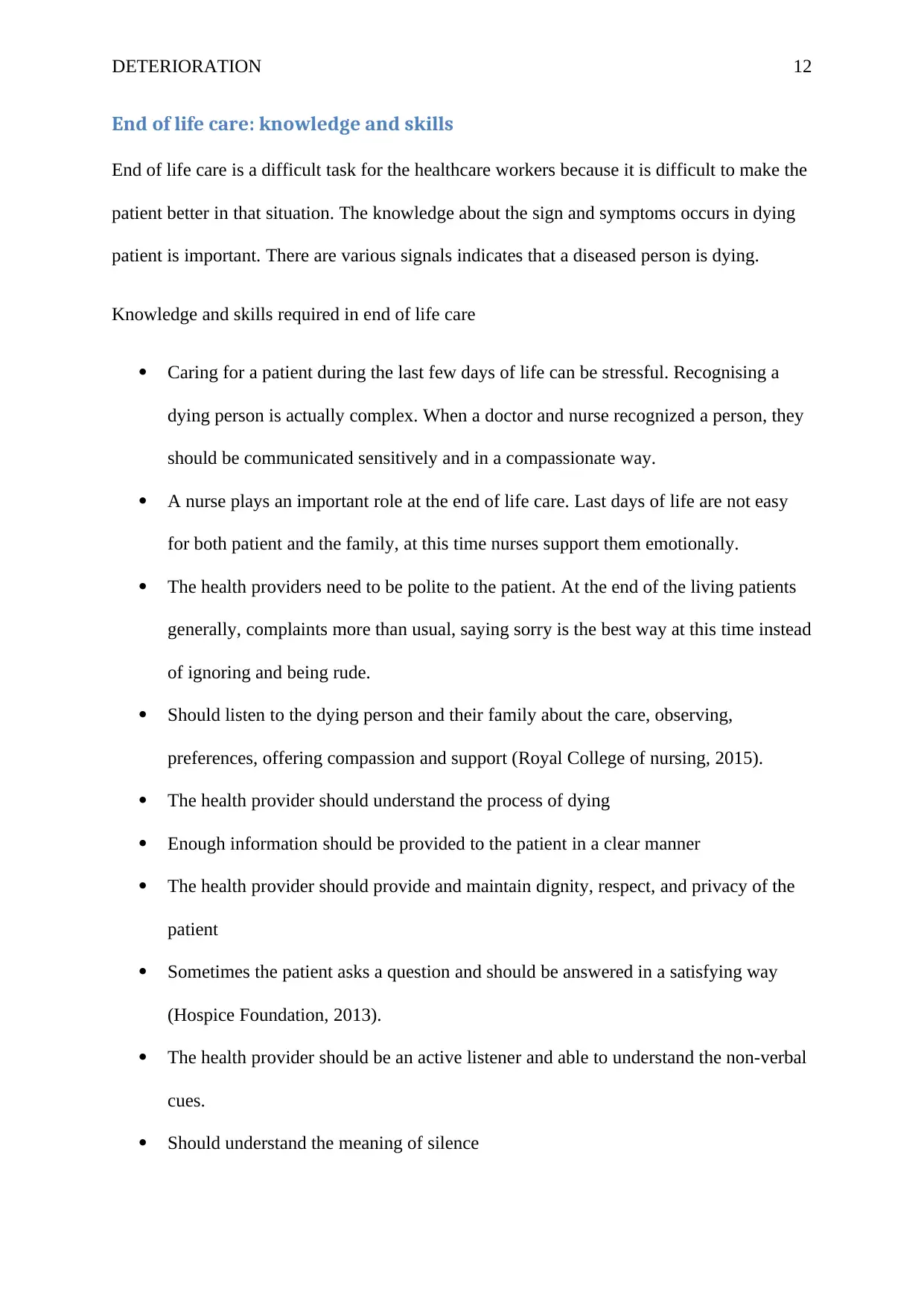
DETERIORATION 12
End of life care: knowledge and skills
End of life care is a difficult task for the healthcare workers because it is difficult to make the
patient better in that situation. The knowledge about the sign and symptoms occurs in dying
patient is important. There are various signals indicates that a diseased person is dying.
Knowledge and skills required in end of life care
Caring for a patient during the last few days of life can be stressful. Recognising a
dying person is actually complex. When a doctor and nurse recognized a person, they
should be communicated sensitively and in a compassionate way.
A nurse plays an important role at the end of life care. Last days of life are not easy
for both patient and the family, at this time nurses support them emotionally.
The health providers need to be polite to the patient. At the end of the living patients
generally, complaints more than usual, saying sorry is the best way at this time instead
of ignoring and being rude.
Should listen to the dying person and their family about the care, observing,
preferences, offering compassion and support (Royal College of nursing, 2015).
The health provider should understand the process of dying
Enough information should be provided to the patient in a clear manner
The health provider should provide and maintain dignity, respect, and privacy of the
patient
Sometimes the patient asks a question and should be answered in a satisfying way
(Hospice Foundation, 2013).
The health provider should be an active listener and able to understand the non-verbal
cues.
Should understand the meaning of silence
End of life care: knowledge and skills
End of life care is a difficult task for the healthcare workers because it is difficult to make the
patient better in that situation. The knowledge about the sign and symptoms occurs in dying
patient is important. There are various signals indicates that a diseased person is dying.
Knowledge and skills required in end of life care
Caring for a patient during the last few days of life can be stressful. Recognising a
dying person is actually complex. When a doctor and nurse recognized a person, they
should be communicated sensitively and in a compassionate way.
A nurse plays an important role at the end of life care. Last days of life are not easy
for both patient and the family, at this time nurses support them emotionally.
The health providers need to be polite to the patient. At the end of the living patients
generally, complaints more than usual, saying sorry is the best way at this time instead
of ignoring and being rude.
Should listen to the dying person and their family about the care, observing,
preferences, offering compassion and support (Royal College of nursing, 2015).
The health provider should understand the process of dying
Enough information should be provided to the patient in a clear manner
The health provider should provide and maintain dignity, respect, and privacy of the
patient
Sometimes the patient asks a question and should be answered in a satisfying way
(Hospice Foundation, 2013).
The health provider should be an active listener and able to understand the non-verbal
cues.
Should understand the meaning of silence
Paraphrase This Document
Need a fresh take? Get an instant paraphrase of this document with our AI Paraphraser

DETERIORATION 13
The carer is able to acknowledge the pain and distress and immediately take a
decision
Record the summery of conversation (Health education England, skills for health, and
skill for care, 2017).
Conclusion
Deterioration can be described as worsening of the health of a patient. Nursing care should be
provided to the patient. The nurses should assess the patient first to understand the situation
of the diseased person. This can be done by using ABCDE approach where A means airway,
b means breathing means circulation, d means disability and e means exposure. Observation
should be done related to O2 saturation, Respiratory rate, blood pressure in mmHg, the
temperature in Fahrenheit or Degree centigrade, level of consciousness from 0 to 4, pain
scoring by various tools such as FLACC, PAT, and CONFORT-B. Actions should be taken
on according to the PACE criteria. An assistant practitioner is the one who manages the
medication of the deteriorating patient. AP is authorized to administer medicine IM and SC
but not intravenous. Understanding the observation and side effects of the medication is very
important to achieve health goals for the patient. Complex wounds are not easy to treat and a
carer should not only just heal the wound but also take care of other aspects such as nutrition.
Some techniques such as assessment, use of antibiotics and Debridement are effective in
chronic wound management. A carer, health provider or nurse should be skilled and have
knowledge of every aspect such listening the patients their family, understand the dying
process, should understand the sign used by a patient, polite and caring.
The carer is able to acknowledge the pain and distress and immediately take a
decision
Record the summery of conversation (Health education England, skills for health, and
skill for care, 2017).
Conclusion
Deterioration can be described as worsening of the health of a patient. Nursing care should be
provided to the patient. The nurses should assess the patient first to understand the situation
of the diseased person. This can be done by using ABCDE approach where A means airway,
b means breathing means circulation, d means disability and e means exposure. Observation
should be done related to O2 saturation, Respiratory rate, blood pressure in mmHg, the
temperature in Fahrenheit or Degree centigrade, level of consciousness from 0 to 4, pain
scoring by various tools such as FLACC, PAT, and CONFORT-B. Actions should be taken
on according to the PACE criteria. An assistant practitioner is the one who manages the
medication of the deteriorating patient. AP is authorized to administer medicine IM and SC
but not intravenous. Understanding the observation and side effects of the medication is very
important to achieve health goals for the patient. Complex wounds are not easy to treat and a
carer should not only just heal the wound but also take care of other aspects such as nutrition.
Some techniques such as assessment, use of antibiotics and Debridement are effective in
chronic wound management. A carer, health provider or nurse should be skilled and have
knowledge of every aspect such listening the patients their family, understand the dying
process, should understand the sign used by a patient, polite and caring.
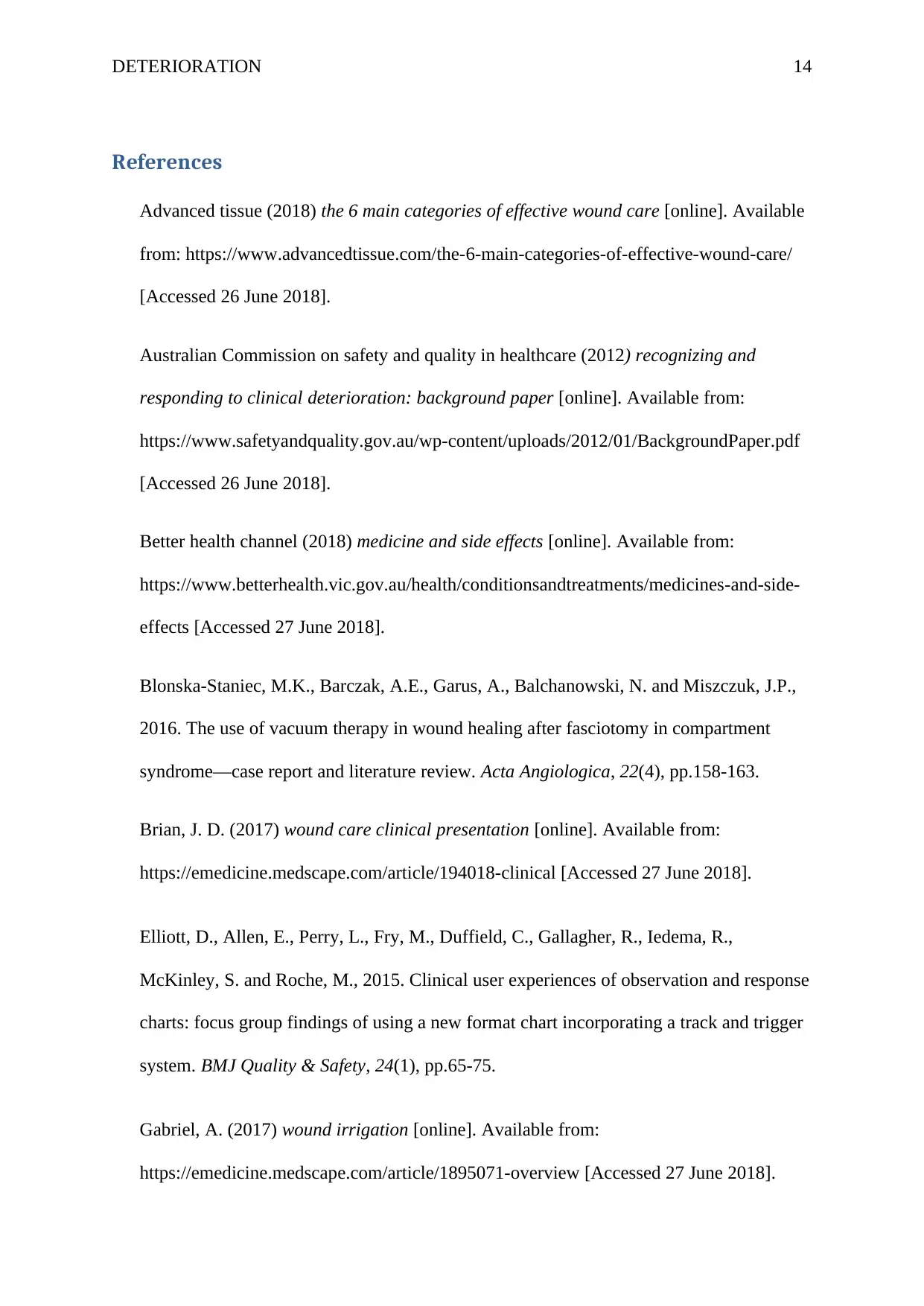
DETERIORATION 14
References
Advanced tissue (2018) the 6 main categories of effective wound care [online]. Available
from: https://www.advancedtissue.com/the-6-main-categories-of-effective-wound-care/
[Accessed 26 June 2018].
Australian Commission on safety and quality in healthcare (2012) recognizing and
responding to clinical deterioration: background paper [online]. Available from:
https://www.safetyandquality.gov.au/wp-content/uploads/2012/01/BackgroundPaper.pdf
[Accessed 26 June 2018].
Better health channel (2018) medicine and side effects [online]. Available from:
https://www.betterhealth.vic.gov.au/health/conditionsandtreatments/medicines-and-side-
effects [Accessed 27 June 2018].
Blonska-Staniec, M.K., Barczak, A.E., Garus, A., Balchanowski, N. and Miszczuk, J.P.,
2016. The use of vacuum therapy in wound healing after fasciotomy in compartment
syndrome—case report and literature review. Acta Angiologica, 22(4), pp.158-163.
Brian, J. D. (2017) wound care clinical presentation [online]. Available from:
https://emedicine.medscape.com/article/194018-clinical [Accessed 27 June 2018].
Elliott, D., Allen, E., Perry, L., Fry, M., Duffield, C., Gallagher, R., Iedema, R.,
McKinley, S. and Roche, M., 2015. Clinical user experiences of observation and response
charts: focus group findings of using a new format chart incorporating a track and trigger
system. BMJ Quality & Safety, 24(1), pp.65-75.
Gabriel, A. (2017) wound irrigation [online]. Available from:
https://emedicine.medscape.com/article/1895071-overview [Accessed 27 June 2018].
References
Advanced tissue (2018) the 6 main categories of effective wound care [online]. Available
from: https://www.advancedtissue.com/the-6-main-categories-of-effective-wound-care/
[Accessed 26 June 2018].
Australian Commission on safety and quality in healthcare (2012) recognizing and
responding to clinical deterioration: background paper [online]. Available from:
https://www.safetyandquality.gov.au/wp-content/uploads/2012/01/BackgroundPaper.pdf
[Accessed 26 June 2018].
Better health channel (2018) medicine and side effects [online]. Available from:
https://www.betterhealth.vic.gov.au/health/conditionsandtreatments/medicines-and-side-
effects [Accessed 27 June 2018].
Blonska-Staniec, M.K., Barczak, A.E., Garus, A., Balchanowski, N. and Miszczuk, J.P.,
2016. The use of vacuum therapy in wound healing after fasciotomy in compartment
syndrome—case report and literature review. Acta Angiologica, 22(4), pp.158-163.
Brian, J. D. (2017) wound care clinical presentation [online]. Available from:
https://emedicine.medscape.com/article/194018-clinical [Accessed 27 June 2018].
Elliott, D., Allen, E., Perry, L., Fry, M., Duffield, C., Gallagher, R., Iedema, R.,
McKinley, S. and Roche, M., 2015. Clinical user experiences of observation and response
charts: focus group findings of using a new format chart incorporating a track and trigger
system. BMJ Quality & Safety, 24(1), pp.65-75.
Gabriel, A. (2017) wound irrigation [online]. Available from:
https://emedicine.medscape.com/article/1895071-overview [Accessed 27 June 2018].
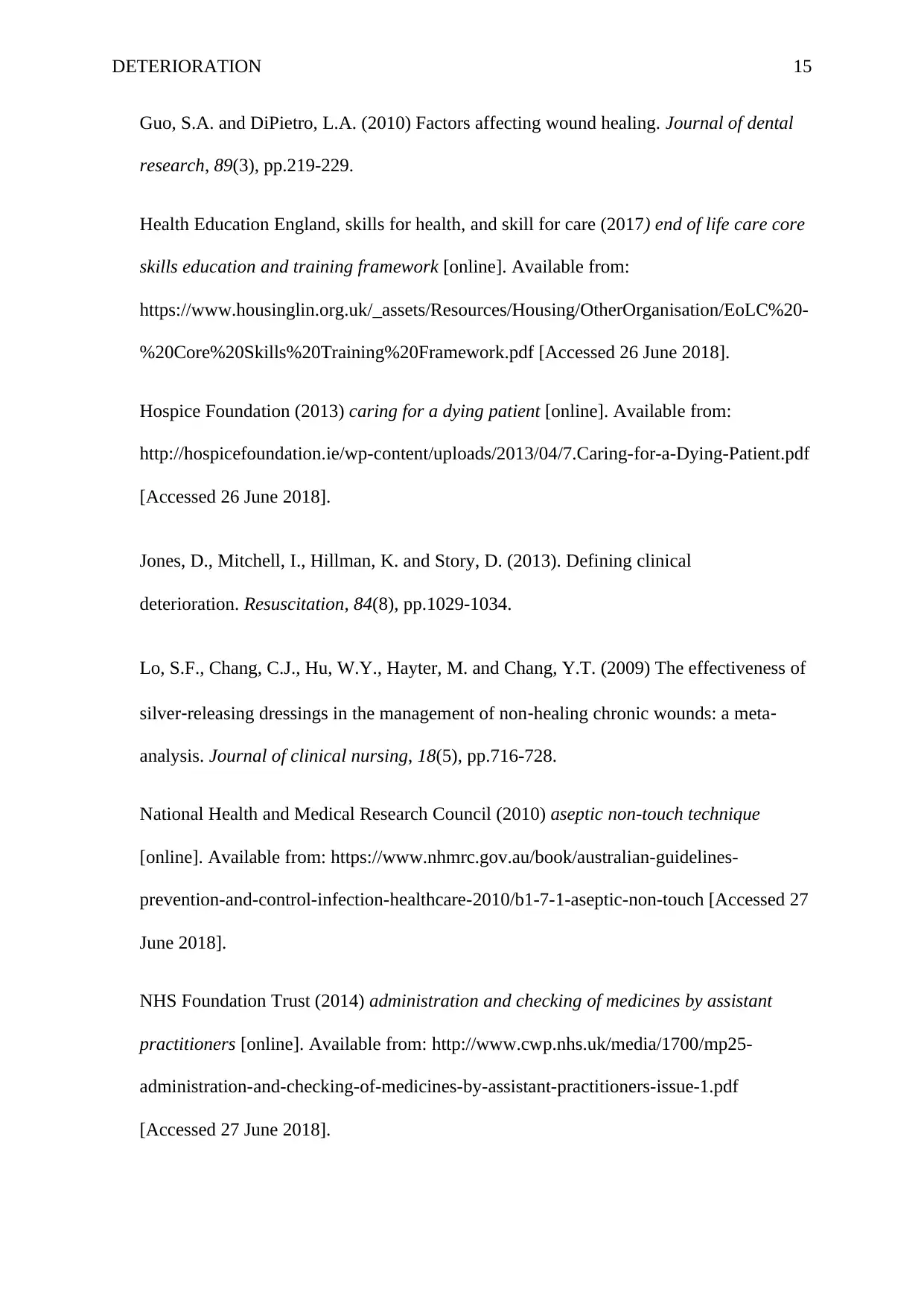
DETERIORATION 15
Guo, S.A. and DiPietro, L.A. (2010) Factors affecting wound healing. Journal of dental
research, 89(3), pp.219-229.
Health Education England, skills for health, and skill for care (2017) end of life care core
skills education and training framework [online]. Available from:
https://www.housinglin.org.uk/_assets/Resources/Housing/OtherOrganisation/EoLC%20-
%20Core%20Skills%20Training%20Framework.pdf [Accessed 26 June 2018].
Hospice Foundation (2013) caring for a dying patient [online]. Available from:
http://hospicefoundation.ie/wp-content/uploads/2013/04/7.Caring-for-a-Dying-Patient.pdf
[Accessed 26 June 2018].
Jones, D., Mitchell, I., Hillman, K. and Story, D. (2013). Defining clinical
deterioration. Resuscitation, 84(8), pp.1029-1034.
Lo, S.F., Chang, C.J., Hu, W.Y., Hayter, M. and Chang, Y.T. (2009) The effectiveness of
silver‐releasing dressings in the management of non‐healing chronic wounds: a meta‐
analysis. Journal of clinical nursing, 18(5), pp.716-728.
National Health and Medical Research Council (2010) aseptic non-touch technique
[online]. Available from: https://www.nhmrc.gov.au/book/australian-guidelines-
prevention-and-control-infection-healthcare-2010/b1-7-1-aseptic-non-touch [Accessed 27
June 2018].
NHS Foundation Trust (2014) administration and checking of medicines by assistant
practitioners [online]. Available from: http://www.cwp.nhs.uk/media/1700/mp25-
administration-and-checking-of-medicines-by-assistant-practitioners-issue-1.pdf
[Accessed 27 June 2018].
Guo, S.A. and DiPietro, L.A. (2010) Factors affecting wound healing. Journal of dental
research, 89(3), pp.219-229.
Health Education England, skills for health, and skill for care (2017) end of life care core
skills education and training framework [online]. Available from:
https://www.housinglin.org.uk/_assets/Resources/Housing/OtherOrganisation/EoLC%20-
%20Core%20Skills%20Training%20Framework.pdf [Accessed 26 June 2018].
Hospice Foundation (2013) caring for a dying patient [online]. Available from:
http://hospicefoundation.ie/wp-content/uploads/2013/04/7.Caring-for-a-Dying-Patient.pdf
[Accessed 26 June 2018].
Jones, D., Mitchell, I., Hillman, K. and Story, D. (2013). Defining clinical
deterioration. Resuscitation, 84(8), pp.1029-1034.
Lo, S.F., Chang, C.J., Hu, W.Y., Hayter, M. and Chang, Y.T. (2009) The effectiveness of
silver‐releasing dressings in the management of non‐healing chronic wounds: a meta‐
analysis. Journal of clinical nursing, 18(5), pp.716-728.
National Health and Medical Research Council (2010) aseptic non-touch technique
[online]. Available from: https://www.nhmrc.gov.au/book/australian-guidelines-
prevention-and-control-infection-healthcare-2010/b1-7-1-aseptic-non-touch [Accessed 27
June 2018].
NHS Foundation Trust (2014) administration and checking of medicines by assistant
practitioners [online]. Available from: http://www.cwp.nhs.uk/media/1700/mp25-
administration-and-checking-of-medicines-by-assistant-practitioners-issue-1.pdf
[Accessed 27 June 2018].
Secure Best Marks with AI Grader
Need help grading? Try our AI Grader for instant feedback on your assignments.
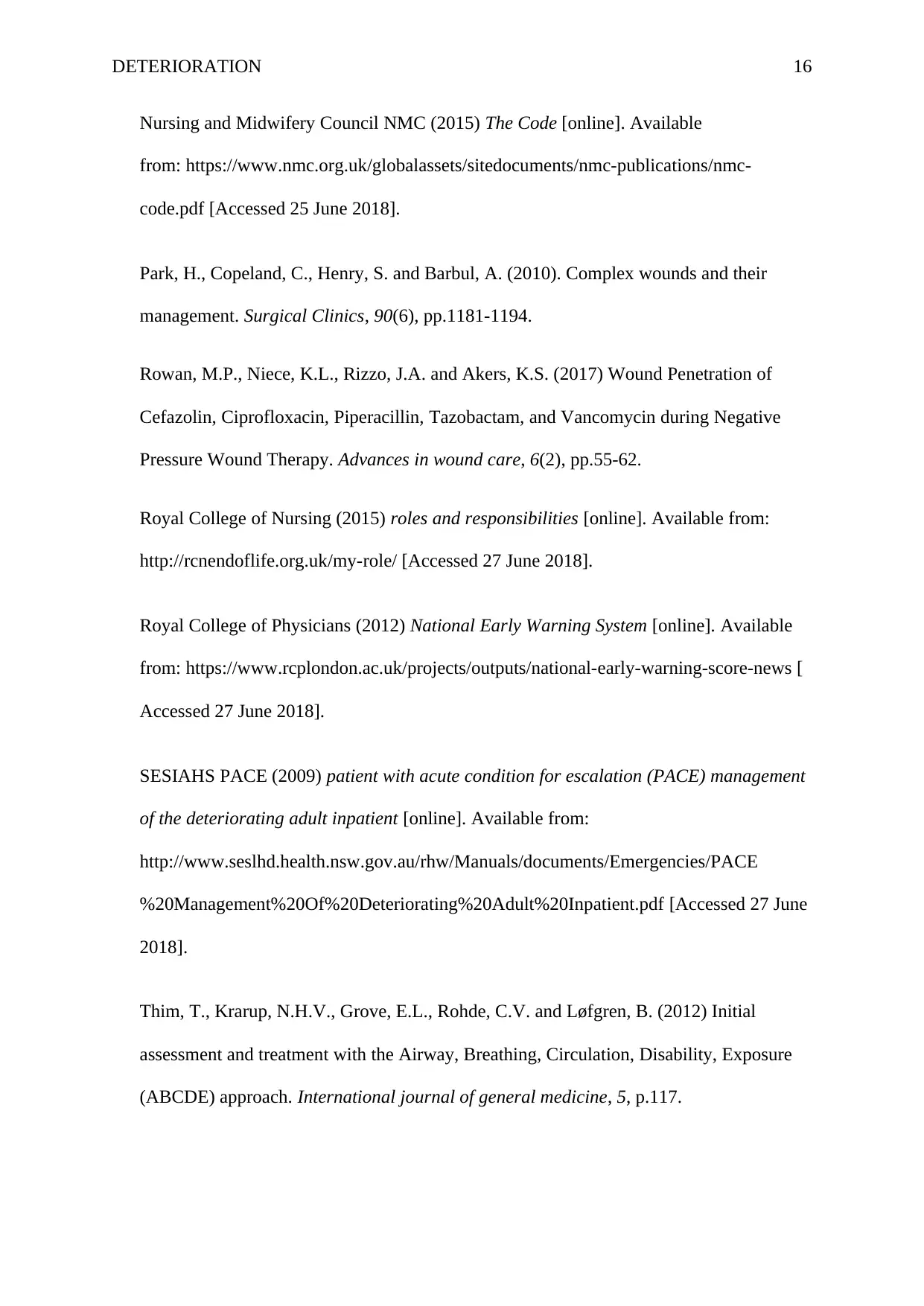
DETERIORATION 16
Nursing and Midwifery Council NMC (2015) The Code [online]. Available
from: https://www.nmc.org.uk/globalassets/sitedocuments/nmc-publications/nmc-
code.pdf [Accessed 25 June 2018].
Park, H., Copeland, C., Henry, S. and Barbul, A. (2010). Complex wounds and their
management. Surgical Clinics, 90(6), pp.1181-1194.
Rowan, M.P., Niece, K.L., Rizzo, J.A. and Akers, K.S. (2017) Wound Penetration of
Cefazolin, Ciprofloxacin, Piperacillin, Tazobactam, and Vancomycin during Negative
Pressure Wound Therapy. Advances in wound care, 6(2), pp.55-62.
Royal College of Nursing (2015) roles and responsibilities [online]. Available from:
http://rcnendoflife.org.uk/my-role/ [Accessed 27 June 2018].
Royal College of Physicians (2012) National Early Warning System [online]. Available
from: https://www.rcplondon.ac.uk/projects/outputs/national-early-warning-score-news [
Accessed 27 June 2018].
SESIAHS PACE (2009) patient with acute condition for escalation (PACE) management
of the deteriorating adult inpatient [online]. Available from:
http://www.seslhd.health.nsw.gov.au/rhw/Manuals/documents/Emergencies/PACE
%20Management%20Of%20Deteriorating%20Adult%20Inpatient.pdf [Accessed 27 June
2018].
Thim, T., Krarup, N.H.V., Grove, E.L., Rohde, C.V. and Løfgren, B. (2012) Initial
assessment and treatment with the Airway, Breathing, Circulation, Disability, Exposure
(ABCDE) approach. International journal of general medicine, 5, p.117.
Nursing and Midwifery Council NMC (2015) The Code [online]. Available
from: https://www.nmc.org.uk/globalassets/sitedocuments/nmc-publications/nmc-
code.pdf [Accessed 25 June 2018].
Park, H., Copeland, C., Henry, S. and Barbul, A. (2010). Complex wounds and their
management. Surgical Clinics, 90(6), pp.1181-1194.
Rowan, M.P., Niece, K.L., Rizzo, J.A. and Akers, K.S. (2017) Wound Penetration of
Cefazolin, Ciprofloxacin, Piperacillin, Tazobactam, and Vancomycin during Negative
Pressure Wound Therapy. Advances in wound care, 6(2), pp.55-62.
Royal College of Nursing (2015) roles and responsibilities [online]. Available from:
http://rcnendoflife.org.uk/my-role/ [Accessed 27 June 2018].
Royal College of Physicians (2012) National Early Warning System [online]. Available
from: https://www.rcplondon.ac.uk/projects/outputs/national-early-warning-score-news [
Accessed 27 June 2018].
SESIAHS PACE (2009) patient with acute condition for escalation (PACE) management
of the deteriorating adult inpatient [online]. Available from:
http://www.seslhd.health.nsw.gov.au/rhw/Manuals/documents/Emergencies/PACE
%20Management%20Of%20Deteriorating%20Adult%20Inpatient.pdf [Accessed 27 June
2018].
Thim, T., Krarup, N.H.V., Grove, E.L., Rohde, C.V. and Løfgren, B. (2012) Initial
assessment and treatment with the Airway, Breathing, Circulation, Disability, Exposure
(ABCDE) approach. International journal of general medicine, 5, p.117.
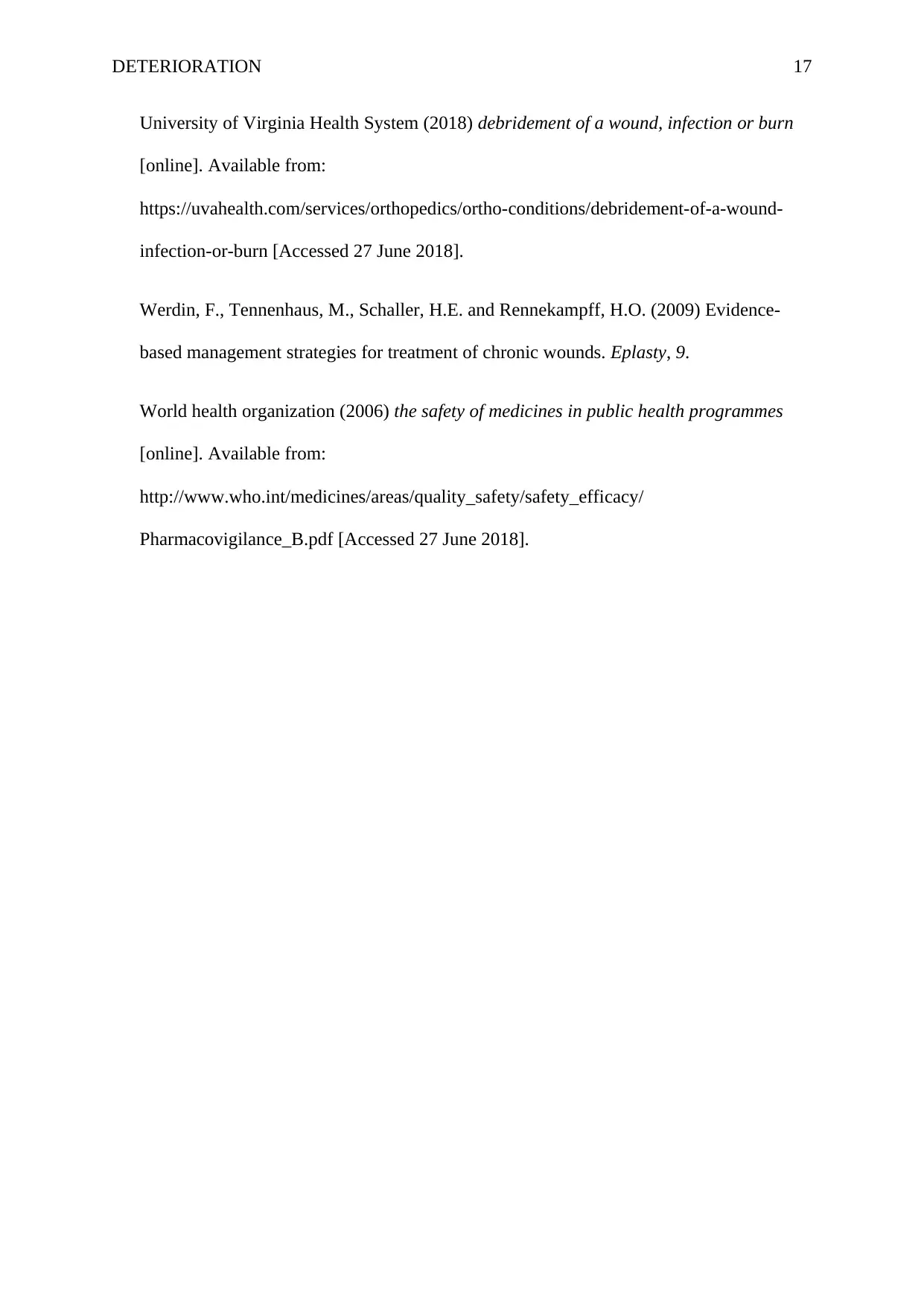
DETERIORATION 17
University of Virginia Health System (2018) debridement of a wound, infection or burn
[online]. Available from:
https://uvahealth.com/services/orthopedics/ortho-conditions/debridement-of-a-wound-
infection-or-burn [Accessed 27 June 2018].
Werdin, F., Tennenhaus, M., Schaller, H.E. and Rennekampff, H.O. (2009) Evidence-
based management strategies for treatment of chronic wounds. Eplasty, 9.
World health organization (2006) the safety of medicines in public health programmes
[online]. Available from:
http://www.who.int/medicines/areas/quality_safety/safety_efficacy/
Pharmacovigilance_B.pdf [Accessed 27 June 2018].
University of Virginia Health System (2018) debridement of a wound, infection or burn
[online]. Available from:
https://uvahealth.com/services/orthopedics/ortho-conditions/debridement-of-a-wound-
infection-or-burn [Accessed 27 June 2018].
Werdin, F., Tennenhaus, M., Schaller, H.E. and Rennekampff, H.O. (2009) Evidence-
based management strategies for treatment of chronic wounds. Eplasty, 9.
World health organization (2006) the safety of medicines in public health programmes
[online]. Available from:
http://www.who.int/medicines/areas/quality_safety/safety_efficacy/
Pharmacovigilance_B.pdf [Accessed 27 June 2018].
1 out of 18
Related Documents
Your All-in-One AI-Powered Toolkit for Academic Success.
+13062052269
info@desklib.com
Available 24*7 on WhatsApp / Email
![[object Object]](/_next/static/media/star-bottom.7253800d.svg)
Unlock your academic potential
© 2024 | Zucol Services PVT LTD | All rights reserved.





